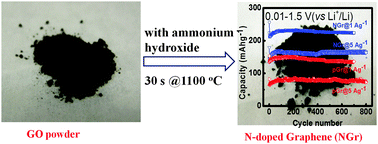Rapid synthesis of nitrogen-doped graphene for a lithium ion battery anode with excellent rate performance and super-long cyclic stability†
Abstract
Chemical doping of nitrogen into graphene can significantly enhance the reversible capacity and cyclic stability of the graphene-based lithium ion battery (LIB) anodes, and first principles calculations based on density functional theory suggested that pyridinic-N shows stronger binding with Li with reduced energy barrier for Li diffusion and thus is more effective for Li storage than pyrrolic and graphitic-N. Here, we report a novel and rapid (∼30 seconds) process to fabricate nitrogen-doped graphene (NGr) by simultaneous thermal reduction of graphene oxide with ammonium hydroxide. The porous NGr with dominant pyridinic N atoms displays greatly enhanced reversible capacities, rate performance and exceptional cyclic stability as compared with pristine graphene. The reversible discharge capacity of the NGr electrode cycled between 0.01–3 V can reach 453 mA h g−1 after 550 cycles at a charge rate of 2 A g−1 (∼5.4 C), and 180 mA h g−1 after 2000 cycles at a high charge rate of 10 A g−1 (∼27 C) without any capacity fading. When charged within 0.01–1.5 V, the NGr anode still exhibits high reversible capacities of 224 mA h g−1 and 169 mA h g−1 after 700 cycles and 800 cycles at a charge rate of 1 A g−1 and 5 A g−1, respectively. Ex situ X-ray photoelectron spectroscopy (XPS) analysis of the NGr electrode upon lithiation and delithiation indicated that the pyridinic-N dominates the capacity enhancement at 3 V, while the pyrrolic-N contributes primarily to Li ion storage below 1.5 V.


 Please wait while we load your content...
Please wait while we load your content...